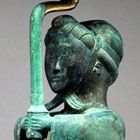J.J. Lally & Co., Oriental Art / New York City, New York
MenuPast Exhibition
Bronze and Gold in Ancient China
March 24 - April 12, 2003
12.
A LARGE BRONZE FIGURAL LAMP
Qin/ Early Western Han Dynasty, circa 3rd/2nd Century B.C.
the tall, heavily cast figure shown standing as a sentry with his arms held up in front of his chest, grasping a cylinder fitted with the stem of a long curving shaft supporting a dish-shaped oil lamp with fluted sides and central spike raised directly over his head, the sentry's broad face with wide open almond-shaped eyes, shown staring intently under stylized feather-like brows engraved as rows of herringbone pattern and with a short moustache engraved in a checkered pattern over his expressionless lips, his ears pierced with plug-shaped ornaments, his hair in rows of finely cast parallel strands gathered into a neat chignon and partially covered with a close-fitting headdress which is tied under his chin with a knot, the ends of his chin-strap shown as pleated ribbons which curl out symmetrically to either side, wearing long plain robes tied at the waist with a pleated sash knotted at the center, with symmetrically down-curved ends matching his chin-strap, a long sword at his waist in a fitted scabbard with small rectangular buckle hooked over the sash, his tunic ending above his ankles, his long under-robe separately cast from darker bronze falling to the ground and fanning out to a straight hem of circular outline, parted at the front to show his feet positioned close together and revealing the fluted bottoms of his long pantaloons and the simple rounded toes of his shoes, the bronze very well preserved, with large areas showing the original pale golden color of the unpatinated metal and with a thin layer of brightly mottled green patination unevenly spread over the smooth surface, and with traces of earth from burial.
Height 13 1⁄4 inches (33.7 cm)
The casting of elaborate sculptural bronze oil lamps, including bronze figures to serve as lamp standards, is a Chinese art form which was highly developed in the Warring States period (475-221 B.C.) and continued well into the Han Dynasty. Several examples of figural bronze lamps have been revealed by recent archaeology in China, and other examples in various museum collections have been published, but the present figure is larger and more elaborately cast than most of the known examples.
Compare the oil lamp cast in the form of a kneeling figure wearing simple robes and a headdress similar to the present example which was discovered in Henan in 1975 and now is in the Henan Provincial Museum; it was first published in Wenwu, 1976, No. 3, p.54, fig.4, and it has been widely published and included in several exhibitions. It was exhibited in a travelling exhibition which opened at the Kunsthaus in Zurich, 1981, and is illustrated in the catalogue by H. Brinker and R. Goepper entitled Kunstchatze aus China, Zurich, 1980, on p.99, no. 19, together with related examples of a kneeling man holding cylinders to receive the stem of a lamp, from the Pillsbury Collection in the Minneapolis Institute of Arts, and another standing figure of a lamp bearer discovered at a late Warring States site in Hebei province in 1964.
For a survey of the subject of bronze lamps in ancient China, see the article entitled 'Zhangguo Qin Han de Deng ji Youguan Wenti' (Issues Regarding Lamps of the Warring States, Qin and Han) by Ye Xiaoyan in Wenwu, 1983, No. 7, pp.78-86.
